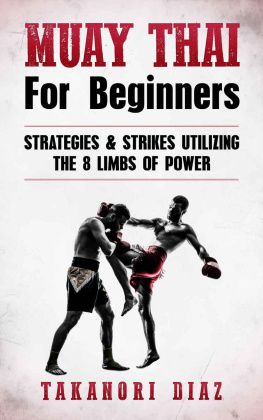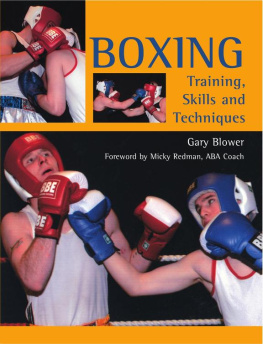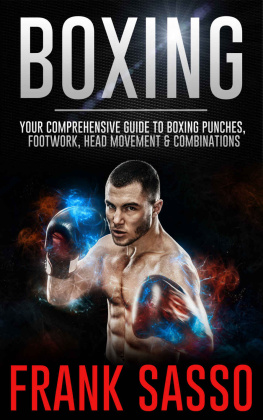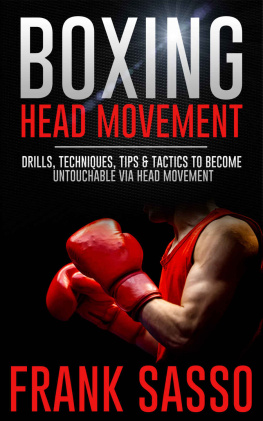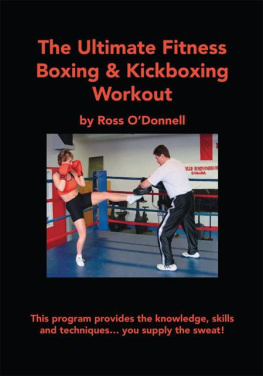Boxing For Beginners
How To Land Punches, Implement Tactics & Increase Your Speed In The Ring
By Takanori Diaz
Contents
Introduction
I want to thank you and congratulate you for purchasing the book, Boxing for Beginners .
This book aims to help beginners start building their boxing skills.
Boxing is not a sport for brutes. The fighter with the strongest punch is not always the winner. At the world championship level of boxing, the fighters who apply the sweet science win.
This book enumerates the principles that the champions use in their fights. You should learn these principles before you try out techniques that will make your own ring presence unique. You need to learn the basic stances, punches and fighting styles. This book helps you choose the best fighting style for you to implement. It also helps you create a game plan depending on the style of fighting that you have chosen.
You should build each of your skills before you start sparring. When you have developed your skills, you should start looking for trainers and sparring partners to help you train for fights. This book also talks about how you can start training with others to further improve your skills and your chances of winning a boxing match.
Thanks again for choosing this book, I hope you enjoy it!
Copyright 2016 by Takanori Diaz - All rights reserved.
This document is geared towards providing exact and reliable information in regards to the topic and issue covered. The publication is sold with the idea that the publisher is not required to render accounting, officially permitted, or otherwise, qualified services. If advice is necessary, legal or professional, a practiced individual in the profession should be ordered.
- From a Declaration of Principles which was accepted and approved equally by a Committee of the American Bar Association and a Committee of Publishers and Associations.
In no way is it legal to reproduce, duplicate, or transmit any part of this document in either electronic means or in printed format. Recording of this publication is strictly prohibited and any storage of this document is not allowed unless with written permission from the publisher. All rights reserved.
The information provided herein is stated to be truthful and consistent, in that any liability, in terms of inattention or otherwise, by any usage or abuse of any policies, processes, or directions contained within is the solitary and utter responsibility of the recipient reader. Under no circumstances will any legal responsibility or blame be held against the publisher for any reparation, damages, or monetary loss due to the information herein, either directly or indirectly.
Respective authors own all copyrights not held by the publisher.
The information herein is offered for informational purposes solely, and is universal as so. The presentation of the information is without contract or any type of guarantee assurance.
The trademarks that are used are without any consent, and the publication of the trademark is without permission or backing by the trademark owner. All trademarks and brands within this book are for clarifying purposes only and are the owned by the owners themselves, not affiliated with this document.
Chapter 1 Boxing Fundamentals: Boxing Stances
Amateur boxers who want to start training in boxing often want to start with punches on their first day. Some coaches may humor them by giving them some time on the mitts or the heavy bag. However, on their first chance, coaches will put their time on training the beginner boxer with the proper stance and footwork. These two factors are the most important parts of boxing fundamentals.
Stance Terminologies:
There two dominant stances in boxing. All current world-caliber boxers use either the orthodox stance or the southpaw stance. To be able to understand the difference between the two, you first need to understand two important combat sports terminologies:
The lead leg refers to the leg that the boxer puts forward. This leg is used by the boxer to determine the distance of the opponent. Together with the jab, a smart fighter can use his lead leg to calculate if his power punches will be able to reach the opponent.
Just like with the legs, the lead hand is also the front-most hand in a boxer s stance. As you will learn later on, the lead hand is usually the weaker punching hand for the boxer but it is useful in setting up the other punches and in confusing the opponent. The rear hand is used for power punches because it is expected to be the more powerful hand of the two.
Boxing Stances:

Photo from http://www.abae.co.uk/aba/index.cfm/about-boxing/boxing-a-beginners-guide/orthodox-or-southpaw/
The orthodox stance is used by right-handed boxers. In this stance, the boxer uses the right hand as the rear hand and the left hand as the lead hand. The lead hand (left) is used for jabbing while the rear hand (right) is used for power punches.
The feet position follows the arm positions. The lead leg should be the same with the lead arm to give the jab maximum reach. By supporting the rear arm with the same rear leg, the boxer will be able to put all his weight behind his punches.
The southpaw, on the other hand, is used mainly by left-handed boxers. The southpaw is the opposite of the orthodox in the sense that the lead hand is the right hand and the rear hand is left hand. The foot positions should also follow the hand positions.

Photo from http://www.abae.co.uk/aba/index.cfm/about-boxing/boxing-a-beginners-guide/orthodox-or-southpaw/
Choose between the two
The first decision that you need to make is whether to become a southpaw or an orthodox fighter. If you are a right-handed fighter, you should practice the orthodox stance. Otherwise, you should use the southpaw stance. However, if you are comfortable with switching stances, you may also practice both. Some professional boxers switch stances to confuse their opponents.
Aside from learning how to fight using these stances, you should also learn how to fight against them. Most people are right-handed so it makes sense to learn fighting against orthodox fighters first. However, if you reach the competitive level of boxing, you will realize that most heavy hitters are southpaws. The good ones usually reach the top because most people are not accustomed with the positioning when fighting against the southpaw.
Chapter 2 Boxing Fundamentals: Footwork
When watching a boxing match, most people pay attention to the hands and the body movements, but they do not put too much attention on the feet. The footwork is the second most important aspect that you need to learn after selecting your stance.
Starting foot position
There are multiple styles when it comes to boxing feet position. In most styles, the lead foot is facing forward towards the opponent. The knees are slightly bent so that they are ready to spring into movement when you throw punches. The distance of the lead foot from the rear foot should not be too wide. They should just be slightly wider than shoulder width. The rear foot could be facing forward or making a 90-degree angle with the lead foot, facing the side.
Footwork can be divided into two types, offensive and defensive footwork.
Offensive footwork
Offensive footwork is used to get closer to the opponent to deliver your blow. Your goal is to get closer to the opponent without getting hit. Your feet should also be positioned to throw power punches at the right angles.
Next page

